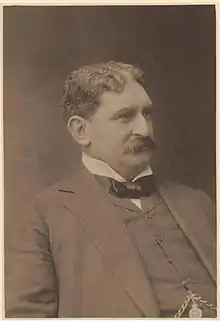William Knox (Victorian politician)
William Knox (25 April 1850 – 25 August 1913)[1] was an Australian businessman and politician.
William Knox | |
|---|---|
 | |
| Member of the Australian Parliament for Kooyong | |
| In office 29 March 1901 – 26 July 1910 | |
| Preceded by | New seat |
| Succeeded by | Robert Best |
| Personal details | |
| Born | 25 April 1850 Melbourne, Colony of New South Wales |
| Died | 25 August 1913 (aged 63) Folkestone, England |
| Nationality | Australian |
| Political party | Free Trade (1901–06) Anti-Socialist (1906–09) Liberal (1909–10) |
| Spouse | Catherine Mary McMurtrie |
| Occupation | Managing director |
Life and career
Knox was born in Melbourne and his family later moved to Horsham and Ballarat. He was educated at Scotch College, Melbourne[2] and joined the State Bank of Victoria in 1866 and worked in various country branches. In January 1884 he married Catherine Mary McMurtrie. In 1885, he became secretary of BHP[2] and in 1888, his yearly salary was increased from £75 to £1,500. He effectively ran the complex organisation of a company that became Australia's biggest company and the world's biggest silver miner. He resigned as secretary in 1893 to become managing director of the Mount Lyell Mining & Railway Company, but was immediately appointed to BHP's board, a position he retained until 1910.
Knox was a councillor on Malvern Shire from 1892 to 1910 and its president from 1892 to 1895. He was elected to the Victorian Legislative Council to represent South Eastern Province in 1898.[1] He supported the federation of Australia and was elected as the first member for Kooyong at the inaugural 1901 election, initially as a member of the Free Trade Party, although he later supported some of the protectionist policies of the Protectionist Party. Knox was responsible for moving a motion to begin each sitting day with prayers. He resigned from parliament shortly after his re-election in 1910, having suffered a stroke.[3] Knox was also one of the seven members of the Prahran & Malvern Tramways Trust, established in 1908 to build part of Melbourne's electric tram network.[4]
The Knoxs had five sons and two daughters. When he and his wife and their younger children were visiting England in 1913, he died at Folkestone, Kent. He had declined a knighthood. His sons included:
- George Hodges (1885–1960), appointed CMG in 1917, speaker of the Victorian Legislative Assembly (1942–1947)
- Robert Wilson (1890–1973), businessman, knighted 1934
- William Johnstone, awarded the Military Cross and died of wounds in 1917
- MacGregor, awarded the Military Cross and permanently incapacitated
References
- "William Knox". Re-Member: a database of all Victorian MPs since 1851. Parliament of Victoria. Retrieved 27 August 2022.
- Mennell, Philip (1892). . The Dictionary of Australasian Biography. London: Hutchinson & Co – via Wikisource.
- Wheeler, Doreen (1983). "Knox, William (1850–1913)". Australian Dictionary of Biography. National Centre of Biography, Australian National University. ISSN 1833-7538. Retrieved 14 May 2013.
- "Members of Prahran & Malvern Tramways Trust as first Constituted". stonlib.stonnington.vic.gov.au. 2013. Retrieved 8 July 2013.